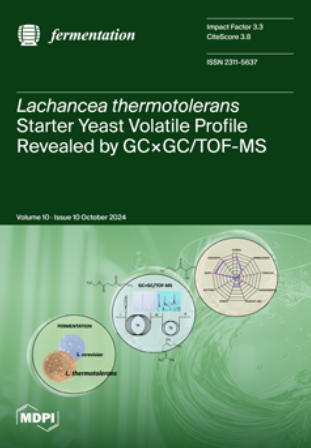生物精炼概念在菠萝废料生产菠萝蛋白酶、乙醇和木糖醇中的应用
IF 3.3
3区 农林科学
Q2 BIOTECHNOLOGY & APPLIED MICROBIOLOGY
引用次数: 1
摘要
菠萝果实生产的巨大潜力会产生相当大的废物,约占菠萝重量的75%,从而导致全球环境问题。因此,迫切需要生物精炼技术将菠萝种植园的废物转化为高附加值的生物产品,包括菠萝蛋白酶、各种糖、低聚木糖、木糖醇和乙醇。本研究的目的是检验将菠萝种植废弃物转化为菠萝蛋白酶、木糖醇和乙醇的有效性。在本研究中,测试了菠萝蛋白酶在菠萝植物废弃物的各个部分的活性。还研究了从菠萝蛋白酶提取的菠萝植物废料中提取乙醇和木糖醇的水解和发酵工艺的配置。菠萝蛋白酶是一种存在于菠萝植物中的蛋白水解酶,可以从菠萝植物废弃物的每一部分中分离出来。研究了几种条件下的酶活性,如粗提取物、纯提取物和干提取物,以确定未来该酶生产下游过程的最佳条件。菠萝蛋白酶的纯化采用沉淀法和透析法,而菠萝蛋白酶的干燥过程采用冷冻干燥法。在粗提取物(1.45±0.06 CDU/mg)、纯化提取物(10.38±0.06 CDU/mg)和干提取物(12.05±0.43 CDU/mg。利用菠萝茎提取菠萝蛋白酶可产生木质纤维素废料,其中淀粉含量为39.47%,半纤维素含量为19.96%,纤维素含量为36.44%,木质素含量为6.05%。淀粉、纤维素和半纤维素含量高,有潜力用作乙醇和木糖醇发酵的原料。本研究采用两种方法进行乙醇和木糖醇发酵:分离水解发酵法(SHF)和半同步糖化发酵法(半SSF)。结果,使用半SSF方法发酵产生的乙醇具有更高的滴度和产量(分别为22.12±0.05 g/L和0.44±0.00 g/g)。然而,木糖醇的生产被发现是微不足道的,无论它是使用SHF还是半SSF获得的。菠萝蛋白酶的纯化采用沉淀法和透析法,而菠萝蛋白酶的干燥过程采用冷冻干燥法。本文章由计算机程序翻译,如有差异,请以英文原文为准。
Application of Biorefinery Concept to the Production of Bromelain, Ethanol, and Xylitol from Pineapple Plant Waste
The massive potential of pineapple fruit production can produce a sizable amount of waste, around 75% (w/w) of pineapple weight, contributing to global environmental problems. For this reason, biorefinery techniques are urgently needed to convert pineapple plantation waste into high-value-added bioproducts including bromelain, various sugars, xylooligoscharide, xylitol, and ethanol. The purpose of this study was to examine the effectiveness of converting pineapple plantation waste into bromelain, xylitol, and ethanol. In this study, the activity of the bromelain enzyme was tested in each part of the pineapple plant waste. The configuration of the hydrolysis and fermentation processes used to make ethanol and xylitol from the rest of the pineapple plant waste from bromelain extraction was also investigated. Bromelain is a proteolytic enzyme found in pineapple plants and can be isolated from every part of pineapple plant waste. Enzyme activity under several conditions, such as crude extract, pure extract, and dried extract, has been studied to determine the best conditions for the downstream process of this enzyme’s production in the future. The purification of bromelain involved the utilization of the precipitation method followed by dialysis, whereas the drying process of bromelain employed the freeze-drying method. The bromelain enzyme specific activity is shown to be highest in the pineapple stem, as observed in crude-extract (1.45 ± 0.06 CDU/mg), purified-extract (10.38 ± 0.06 CDU/mg), and dried-extract (12.05 ± 0.43 CDU/mg) conditions. Using the pineapple stem to extract bromelain can produce lignocellulosic waste, which is made up of 39.47% starch, 19.96% hemicellulose, 36.44% cellulose, and 6.05% lignin. The high content of starch, cellulose, and hemicellulose has the potential to be used as feedstock for ethanol and xylitol fermentation. In this study, ethanol and xylitol fermentation were carried out using two methods: separate hydrolysis and fermentation methods (SHF) and semi-simultaneous saccharification and fermentation methods (semi-SSF). As a result, fermentation using the semi-SSF method produced ethanol with a higher titer and yield (22.12 ± 0.05 g/L and 0.44 ± 0.00 g/g, respectively). However, the production of xylitol was found to be insignificant, regardless of whether it was obtained using SHF or semi-SSF. The purification of bromelain involved the utilization of the precipitation method followed by dialysis, whereas the drying process of bromelain employed the freeze-drying method.
求助全文
通过发布文献求助,成功后即可免费获取论文全文。
去求助
来源期刊

Fermentation-Basel
BIOTECHNOLOGY & APPLIED MICROBIOLOGY-
CiteScore
3.80
自引率
18.90%
发文量
594
审稿时长
7 weeks
期刊介绍:
Fermentation-Basel is an international open access journal published by MDPI, focusing on fermentation-related research, including new and emerging products, processes and technologies, such as biopharmaceuticals and biotech drugs. The journal enjoys a good reputation in the academic community and provides a high-impact forum for researchers in the field of bioengineering and applied microbiology.
 求助内容:
求助内容: 应助结果提醒方式:
应助结果提醒方式:


